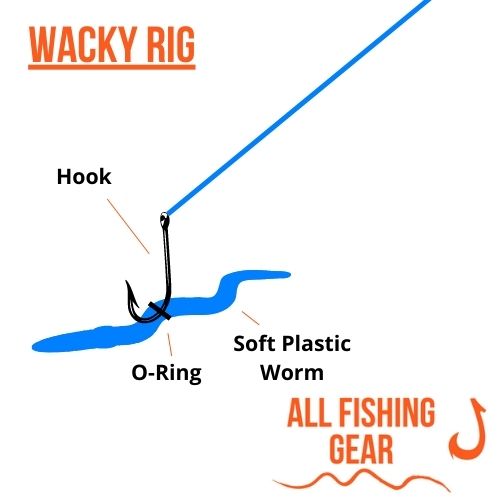The best way to fish a wacky rig is with a soft plastic worm and an octopus hook when targeting bass near the bottom or hiding in difficult to access structure.
The wacky rig is a somewhat unconventional way to fish with soft plastic worms, but there’s no denying that they are highly effective when used in the right situations. If you’re not familiar with the wacky rig and want to know how to use it, keep reading – I am a big fan and would like to share my experiences.
This is a very simple, easy-to-use lure style that is outstanding for catching hungry bass.
Table of Contents
What is a Wacky Rig?
A wacky rig consists of your choice of hook, an O-ring and a plastic worm. There are many variations that you can go with when using this type of presentation and many hook manufacturers now produce hooks that are specialized to be used in a wacky style.
It’s usually recommended to use a 1/0 or possibly a 2/0 hook when fishing with a wacky rig. An octopus style hook is better in most cases and you can add some visual attraction by using a red hook in some cases.
There are also a lot of different O-rings you can use with wacky rigs. These O-rings are designed for two specific purposes. They’re mostly made to keep your hook in place so you won’t have to run the hook through your plastic worm, which will hamper the action you might get and also risk having your worm more easily bitten in half. Secondly, the O-rings are made to help you get the most action out of your worm as you twitch it up and down.
Finally, there are a few different plastic worms that are considered best when fishing with a wacky rig. Most anglers use a Senko style worm since it’s thick and presents a good amount of fluttering action. However, you can also opt for a stick bait or even a finesse worm. Some anglers have had quite a bit of success wacky rigging with flukes, tubes and creature baits, but we recommend sticking to a worm that is symmetrical on both sides for the best possible effect.

When to Use a Wacky Rig?
The wacky rig is an excellent choice of lure for catching suspended bass, as well as fish that are on or near the bottom. It’s meant to visibly look like a small minnow swimming in the water and you want to have a good amount of ‘flutter’ action. You can get this fluttering action by gently twitching your rod tip up and down. Don’t twitch the lure too hard or your worm will have too much bend, which might spook any nearby fish.
The wacky rig can be fished at any time of the year in virtually any sort of situation that involves medium or shallow water. It’s not a good deep-water tactic since the lure is relatively lightweight and won’t sink farther than about 8 to 10 feet in most cases. You can use the wacky rig to target fish in open water, or to draw bass out of heavy cover.
In addition to being a great bass fishing lure, the wacky rig is also ideal for catching walleye, pike, trout and many other freshwater fish that are found in lakes and reservoirs. It works beautifully in water that’s clear since the wacky rig relies on visual presentation to entice fish to bite.
How to Use a Wacky Rig
You can throw the wacky rig just about anywhere, but I’ve often found it often works best to target fish that are holding up in cover near the bank. It’s not a lure you want to throw into cover since you’re using an exposed hook, but you can get lots of bites by throwing the wacky rig close to brush piles, trees, standing timber, piers and other structures.
One of my favorite situations for using a wacky rig is when fishing over submerged grass, especially if you know there are fish hiding in the grass. You can cast the wacky rig in and let it sink down until it gets right above the grass before you begin twitching it. When done correctly, this technique will draw bass out of the grass and make them strike.
Many professional anglers have mastered the skill of skipping the wacky rig under docks and other cover. Since the lure is pretty lightweight, you can use a side-arm cast to make the worm skip across the water and get into those hard-to-reach areas where monster bass like to hide out.
Conclusion
The wacky rig is a great lure to explore and try in a variety of different scenarios for bass fishing or other species. If you experiment with the wacky rig, you might be able to find out certain ways to use it in specific lakes or certain situations to catch fish when other lures can’t get the job done.
It’s best to use braided line if you’re going to use the wacky rig near cover, but stick with fluorocarbon, or at least a fluoro leader line for fishing in open water. The wacky rig is a sensational lure for catching big fish, so be sure to add this one to your tackle box for your next fishing trip.
